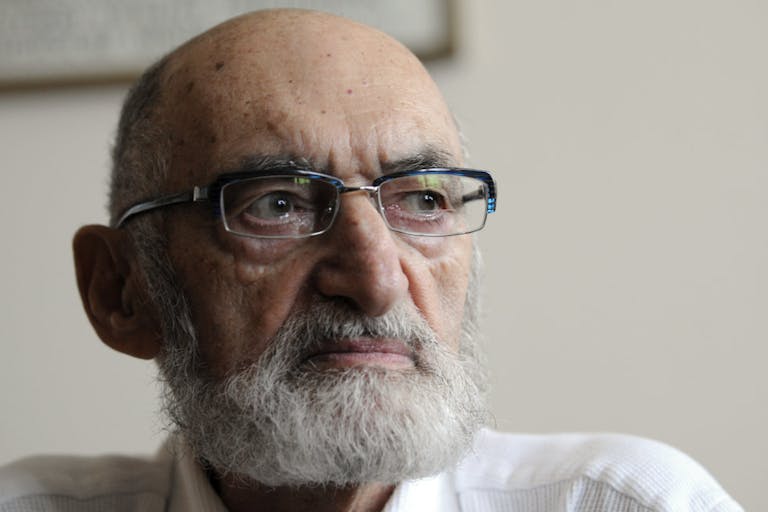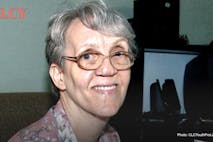
Report: Kansas abortions hit record high with 47% increase in minors
Nancy Flanders
·
Guest Column·By Pete Baklinski
Canada’s ‘father of abortion’ was a Holocaust survivor. Did trauma make him a killer?
(Campaign Life Coalition) It has long haunted me how Henry Morgentaler, sometimes referred to as Canada’s “father of abortion,” survived Nazi concentration camps only to go on to perpetrate similar horrors against the smallest and most vulnerable members of the human family: preborn children.
How did a Jewish Holocaust survivor from Poland—someone who endured the worst of man’s inhumanity to man at the infamous Nazi camps of Auschwitz-Birkenau and later Dachau—go on to dehumanize and destroy tens of thousands of preborn human beings, robbing them of their most fundamental right: the right to life?
Morgentaler’s biographies provide vivid accounts of his survival, though some critics question the credibility of those accounts. Eleanor Wright Pelrine, in her 1975 book Morgentaler: The Doctor Who Couldn’t Turn Away, wrote about how Nazis rounded up the 21-year-old Morgentaler from a Jewish ghetto in August 1944, herding him along with his mother and younger brother, Mumek (Mike), onto an overflowing train bound for the dreaded Auschwitz-Birkenau camp where over a million people were murdered.
It was during the “selection” process after arriving that Morgentaler saw his mother for the last time. He and his brother were selected for work, their mother for the gas chambers. Prisoners had their belongings confiscated, they were stripped naked, shaved from head to foot, and provided striped prison garb along with wooden shoes. A huge chimney nearby spewed forth black, stinking smoke, a brief testimony lingering in the sky to those who were murdered in the gas chambers and were later cremated.
Morgentaler was soon transferred to the Dachau work camp, where—in a deliberate effort to dehumanize prisoners—he was stripped of his name and identified only by a number: 95077. The camp routine consisted of 12 hours of hard labor and 5-6 hours of sleep. Food, consisting of watery soup and bread, was rationed and insufficient. Prisoners died from malnutrition, exhaustion, and exposure. There were constant beatings. Fear was everywhere. One day, Morgentaler, starving and sick, reported to the infirmary. He glanced at his reflection in the mirror. The emaciated figure he saw staring back at him filled him with horror.
“I looked like death incarnated—and I started to cry. I thought it must be the end,” he recounted.
As the war neared its end, Morgentaler and his brother were transferred from camp to camp as their captors tried to prevent them from falling into Allied hands. They had numerous close brushes with death. In late April 1945, the brothers escaped from a train that came under attack by Allied aircraft. Sympathetic German peasants helped them to freedom.
“I was 22, still young, had survived the concentration camp and serious disease,” recounted Morgentaler. “Everything was beautiful. Everything had evolved into a celebration of life.” Eventually, he tracked down his sweetheart Chava (Eva), completed four years of medical studies, and immigrated to Canada by way of Belgium.
Throughout his life, Morgentaler would experience nightmares of what he had endured. “I’m being pursued by high-booted Nazi soldiers, caught, and then I blank out or wake up in a sweat,” he related. He maintained a deep-seated feeling of dread about being crushed by hostile authorities, helpless to do anything about it, like “an insignificant little worm, and there is not much I can do except wiggle out of some situation.”
Morgentaler’s history of abortion activism is well-known to those involved in Canada’s pro-life movement. After the war, he immigrated to Montréal, where, in 1953, he finished medical studies and began to practice medicine. By the late 1960s, he openly defied Canadian law by performing illegal abortions.
When abortion became legally permitted in 1969 under certain conditions, Morgentaler defied those restrictions, becoming the focus of numerous legal battles. These culminated in the 1988 Supreme Court decision (R. v. Morgentaler), which struck down Canada’s abortion law. As a result, preborn children were left with no legal protection—a situation that persists today, where abortion is allowed on demand, for any reason or no reason, at any stage of pregnancy.
For pro-life advocates, Morgentaler personified the abortion industry. He is viewed as the one most responsible for almost five million preborn children killed by abortion since 1969. He estimated that he had personally committed some 80,000 abortions during his medical career.
He was a pioneer of vacuum aspiration abortions in Canada, refining the method and making it more efficient. He was so indifferent about the killings that he even invited a camera crew to film him in the act. The film captures what will one day serve as evidence of Morgentaler’s crimes against humanity.
His abortion tools: murder weapons. The nurse who assisted him: an accomplice to murder. His clinic: a crime scene. [WARNING: Video below contains disturbing content.]

“Are you feeling anything?” Morgentaler asks the mother on the operating table. She has her legs spread apart in preparation for her living baby to be killed as it is sucked out of her.
“No, nothing,” the woman replies.
“Just breathe,” the nurse tells the woman.
Morgentaler then nods for the nurse to turn on the vacuum with its suction ten times more powerful than a household vacuum cleaner. The video does not show the brutality against the small human being.
The suction curettage will enter the womb, the sacred and protective home of the baby. It will suck up the life-supporting amniotic fluid. It will then find its way to the living, developing baby. The powerful suction will then crush, shred, and pulverize the tiny life, utterly destroying it. The machine will suck everything out of the woman’s body—leaving her empty and breaking the maternal bond she had with her child.
It’s a procedure that is defended as “safe” for the mother, but not for the baby. Abortion is never “safe” for the preborn human.
In the background, the machine can be heard whirling into action. Moments later, the nurse tells the woman, “You’re not pregnant anymore, okay? It’s all over.”
“Feeling alright?” asks Morgentaler.
“Yes,” replies the woman.
How did Morgentaler, the victim, become Morgentaler, the perpetrator? How did the oppressed become the oppressor, the sufferer the killer?
I have struggled with these questions ever since finding out that Morgentaler was a Holocaust survivor. Only recently did I come across an answer while reading Viktor Frankl’s 1946 book Man’s Search for Meaning. The Austrian psychologist wrote the book to capture his experience of and reflections on surviving three years in four Nazi concentration camps, including Auschwitz.
Both Frankl and Morgentaler passed through this camp, but at different times. The book offered postwar mankind a ray of hope in the face of so much darkness. It immediately became an international bestseller and went on in 1991 to be named one of the ten most influential books in the United States.
In his book, Frankl outlines the three stages of a prisoner’s mental reactions (psychological response) to his imprisonment. First, there is the shock upon admission, often characterized by disbelief and even denial. Then follows the apathy toward brutal camp life where prisoners experience a blunting of emotions— or even an emotional death—as a defence mechanism against the horror around them. Finally, there is the mental state after liberation, where now-freed prisoners often experience emotional confusion, disorientation, and even disillusionment.
It was while I was reading about this last mental state that the words seemed to jump off the page. They appeared so aptly to describe how Morgentaler turned into a killer.
Frankl writes that after liberation, many prisoners “could not escape the influences of the brutality which had surrounded them in camp life.” Now that they were free, “they thought they could use their freedom licentiously and ruthlessly.”
“The only thing that had changed for them was that they were now the oppressors instead of the oppressed. They became instigators, not objects, of willful force and injustice.”
He writes about how he witnessed a friend after liberation walking to a field of newly sprouted green crop. “Automatically, I avoided it,” writes Frankl, “but he drew his arm through mine and dragged me through it. I stammered something about not treading down the young crops. He became annoyed, gave me an angry look and shouted, ‘You don’t say! And hasn’t enough been taken from us? My wife and children have been gassed—not to mention everything else—and you would forbid me to tread on a few stalks of oats!’”
In another instance, Frankl writes about a different friend who, after liberation, thrust a hand in front of the author’s face, vowing: “May this hand be cut off if I don’t stain it with blood on the day when I get home.”
Frankl’s analysis of these kinds of mental reactions is sobering. He calls it “moral deformity.”
“Only slowly could these men be guided back to the commonplace truth that no one has the right to do wrong, not even if wrong has been done to them,” he wrote.
“We had to strive,” he continued, “to lead them back to this truth, or the consequences would have been much worse than the loss of a few thousand stalks of oats.”
Indeed, in the case of Morgentaler, the consequences were much worse—the loss of tens of thousands of preborn humans whose lives he personally snuffed out at his killing centres in Canada….
Continue reading the entire article at Campaign Life Coalition.
Author Bio: Pete Baklinski is the Communications Director for Campaign Life Coalition. He is married to Erin and the father of nine children. He lives in Combermere, Ontario. He can be followed on X: @PeteBaklinski, AKA “Pro-life Canadian Man.”
Editor’s Note: This article was originally published at Campaign Life Coalition and is reprinted here in part with permission.
Follow Live Action News on Facebook and Instagram for more pro-life news.
Live Action News is pro-life news and commentary from a pro-life perspective.
Contact editor@liveaction.org for questions, corrections, or if you are seeking permission to reprint any Live Action News content.
Guest Articles: To submit a guest article to Live Action News, email editor@liveaction.org with an attached Word document of 800-1000 words. Please also attach any photos relevant to your submission if applicable. If your submission is accepted for publication, you will be notified within three weeks. Guest articles are not compensated (see our Open License Agreement). Thank you for your interest in Live Action News!

Nancy Flanders
·
Human Interest
Melina Nicole
·
Issues
Wesley J. Smith
·
Issues
Michael J. New
·
Issues
Right to Life UK
·
Politics
Tabitha Goodling
·
Guest Column
Pete Baklinski
·
Guest Column
Pete Baklinski
·
Activism
Pete Baklinski
·
Abortion Pill
Pete Baklinski
·
Activism
Pete Baklinski
·